|
Sunday, August 19, 2007
Progress Notes
The roofing of the old museum has been completed (photos 1 and 2) which surely must be a relief for the roofers who did the work during the worst spell of heat of the summer. Dan Henley was our liaison with the Missouri Builder's Company (photo 3) with which we contracted the work. Dan is a brother of Norris Henley, who owns the jewelry store in Eldon. He is applying a new type of roofing material which is lighter and has good insulating value as well.
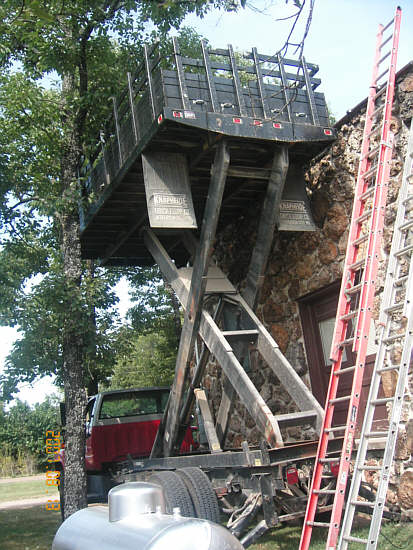 1 roofing begins old museum
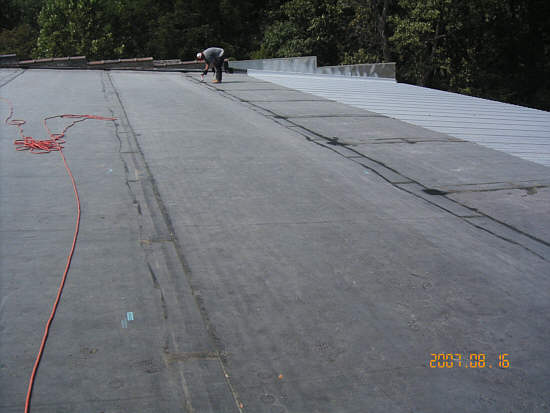 2 roof
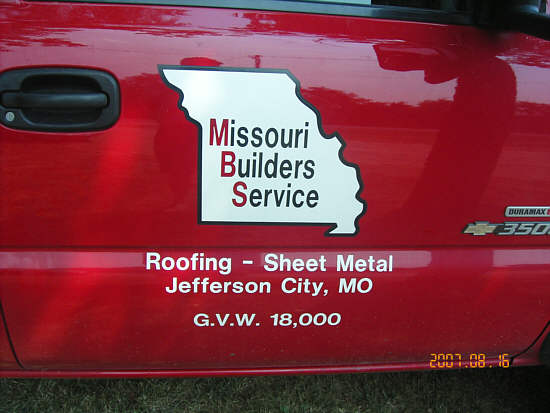 3 Roof Builders
The drywall has been placed (photo 4) and now we will have the painting done followed by the floor coverings. Soon we will have the addition finished but then the real work begins for the museum team because we have to plan floor layouts and begin the transfer of those items going to the new space.
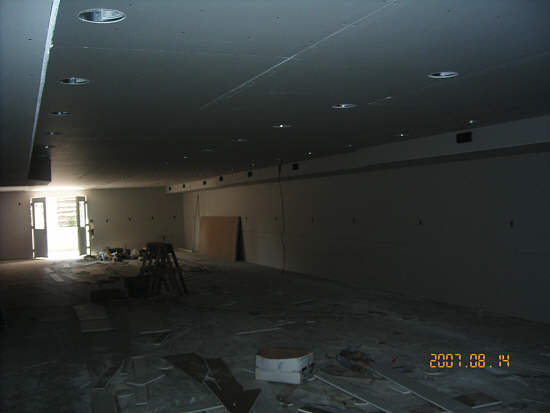 4 dry wall lower floor
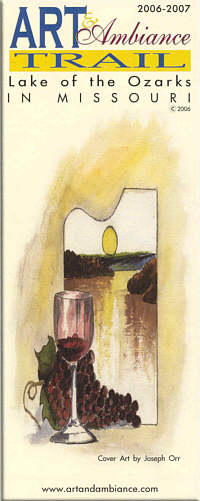 5 Art and Ambiance Trail Folder |
Last weekend we hosted the Miller County Museum display at the Art and Ambiance Trail exhibition at Stonecrest Mall (photos 5-9). It was an enjoyable time to have the opportunity to speak with those who stopped by to chat. On display were many items including the quilts we have for raffle later this year (photo 10). The larger quilt in the photo was handmade by Elva Steen whose portrait photo was placed next to the quilt (photo 11). A short biography of Elva was also on display (photo 12). One interesting attraction was the item I showed on this page last week (photo 13) which was the mule shoe over which a cedar tree trunk had grown. Very few people recognized what it was. The most interesting display we had according to a count of the people who stopped to view it was the Pinkney Miller display prepared by Sharon Cogdill, ex officio President of the Miller County Historical Society. Pinkney (photo 14) was the first white child born in Miller County and his father, William Miller (photo 15), was instrumental in getting Miller County registered with the State as well as getting Tuscumbia chartered as an incorporated village of the State of Missouri. You can read more about the Miller family in Windows to the Past written by Peggy Hake under the Publications section which is listed at the top right of our home website page. Also pictured here are the homes of William and Pinkney (photos 16 and 17).
|
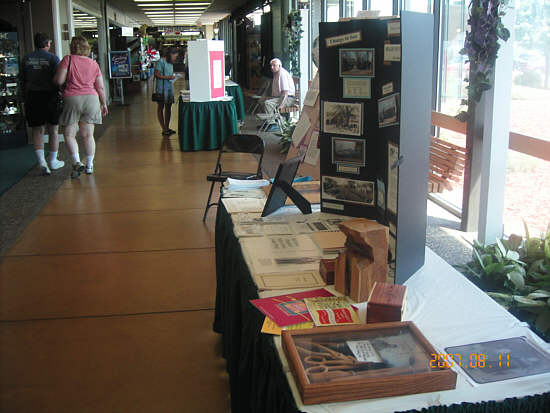 6 Art and Ambiance Photo
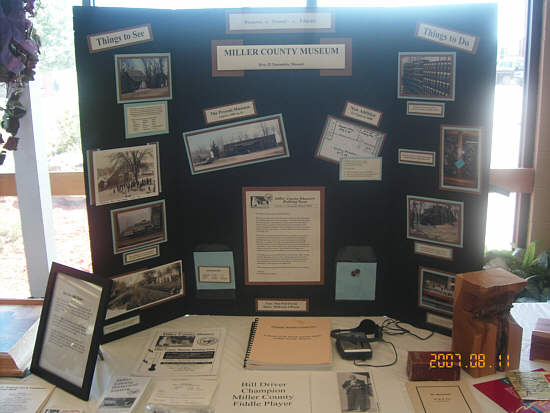 7 Main Display Board
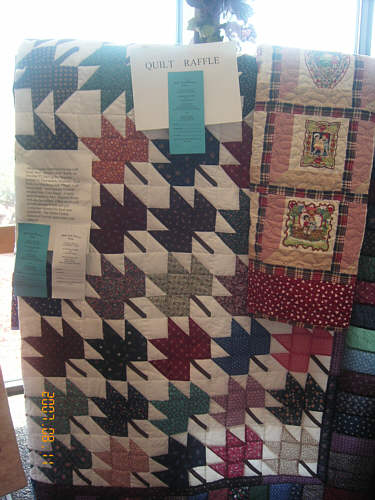 10 Quilts for Raffle
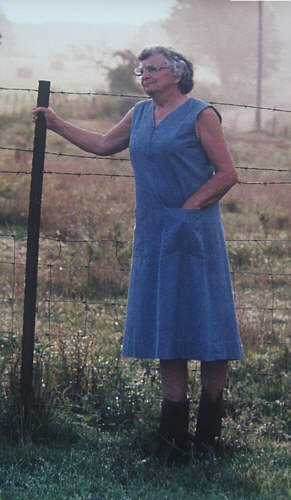 11 Elva Steen
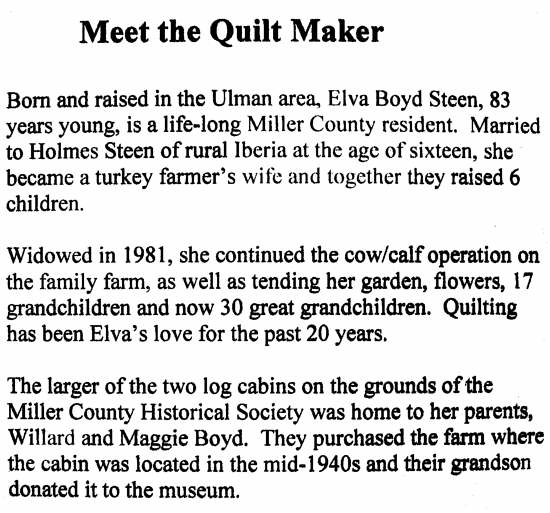 12 Elva Steen Narrative
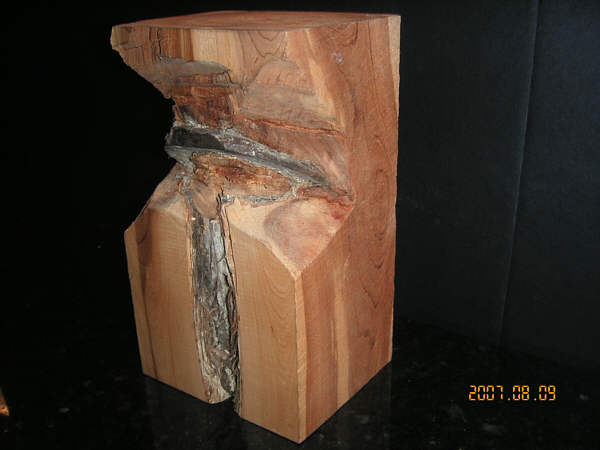 13 What's This
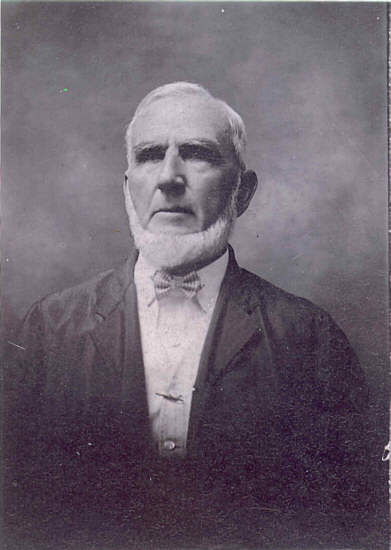 14 Pinkney Miller
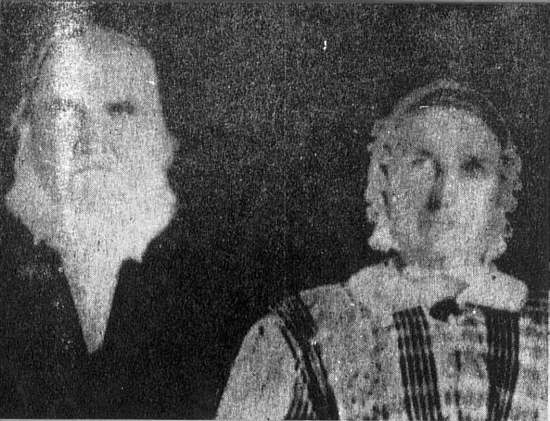 15 William Miller and wife
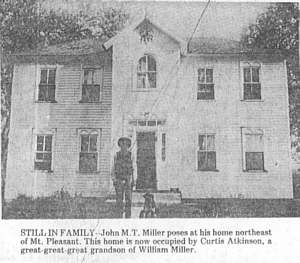 16 original miller house |
|
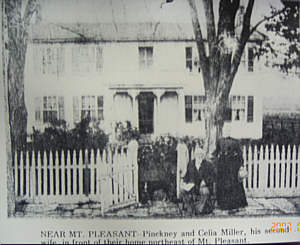 17 Pinckney Miller home |
A couple of weeks ago I wrote a few paragraphs about Donald Wyrick, former Warden of the Missouri State Penitentiary, who was a Miller County native. As I indicated then, Donald was the longest tenured Warden of the state penitentiary which was the oldest penitentiary west of the Mississippi river. I have just finished reading the biography of Donald written by his daughter, Carol Wyick, who herself had a career with the state correctional department. The book is a fascinating history of the challenges, sometimes dangerous and fearful, which Donald had to face while dealing with hardened criminals in the state pen. I certainly am proud to know that Donald was such a wonderful representative of our County during those years he was Warden. You can order the book from Carol according to these instructions:
If you are interested in purchasing a copy of the book, please follow the instructions below.
Price per book is $15.00, which includes shipping/handling charges and packaging/processing fees.
Method of payment is by bank money order only and should be remitted to Carol A. Wyrick, 16648 Stanfield Road, Boonville, Missouri 65233.
Upon receipt of payment, your book will be mailed to the address you provide.
Here is a photo (photo 18) taken at the last monthly meeting of the MCHS Board on August 15. Left to right are Jim Clark, Wanda Wright, Donna Carrender, Carl McDonald, Judy Prince, Peggy Hake (secretary), Betty Kallenbach (treasurer), Joe Pryor (president), Helen Schulte (gift shop manager), Nancy Thompson (museum director), Corrine Gillian, Joe Cochran. Sharon Cogdill was absent. I think this is the first time we displayed a photo of the board members.
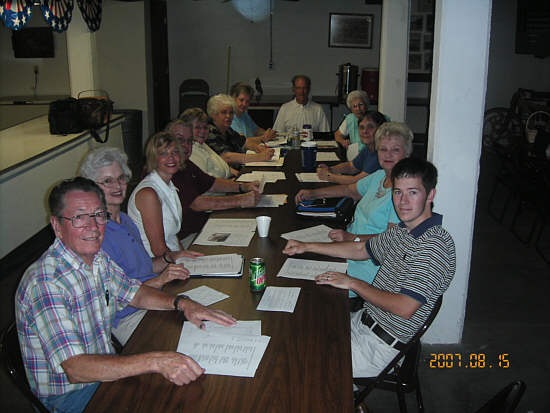 18 MCHS Board Bill and Connie Prather (photo 19) of Iberia were our volunteer hosts last Wednesday. For many years Bill has owned and managed the Shelter Insurance Company of Iberia and Tuscumbia. He has been an avid bird and big game hunter in the past but has some trouble with his knees and isn't hunting so much now. He remembered that years ago he headed up a bowling team which included several Tuscumbia men including Dr. Marshall Humphreys and LeRoy Snodgrass, who at the time was circuit judge. Dr. Marshall and LeRoy were known to be very competitive in about anything they did. LeRoy, was guard on the high school basketball team back in the thirties when it won third place in the state tournament. Years ago Bill bought the Shelter Insurance Company from Garrett Berry, who at the time lived in Tuscumbia; and isn't it a coincidence that Garrett's niece, Ruby (Berry) Rush and her husband Billy Rush (photo 20), chose this day to visit the museum! I had a very nice chat with them.
I remembered Ruby's father, Verbal Berry very well, as well as his other children including Earl, Billy Gene, Loyd, and Lelah. Ruby told me something I hadn't known before; she had cared for my grandmother, Sadie (Abbett) Bear off and on when she was paralyzed by Parkinson's disease. As an aside, here are three photos of Sadie (Abbett) Bear; the first (photo 21) when she was young and healthy, the second (photo 22) in middle age without evidence of disease, and the third where she demonstrates the stiffness of Parkinson's disease (photo 23). Billy Rush, Ruby's husband, was raised around Olean but he is related to the Rush family that has lived for many years in the Tuscumbia Eugene area. Billy's father, Ishmael, was a brother to Roy Rush, whose children went to school at Tuscumbia, several of whom attended when I did.
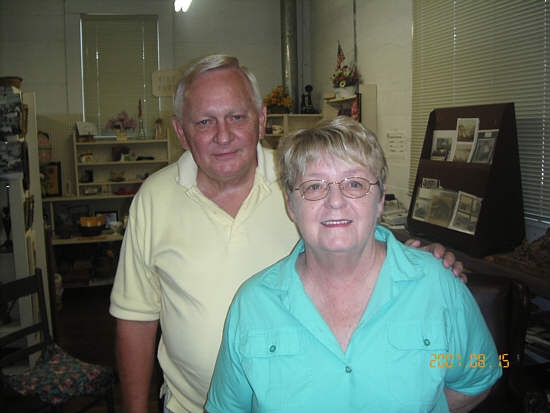 19 Bill and Connie Prather
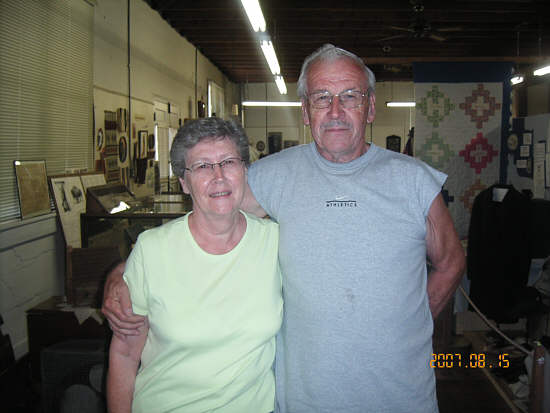 20 Ruby and Billy Rush
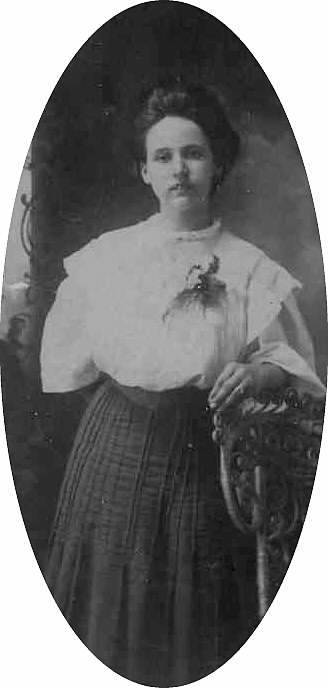 21 Sadie(Abbett) Bear
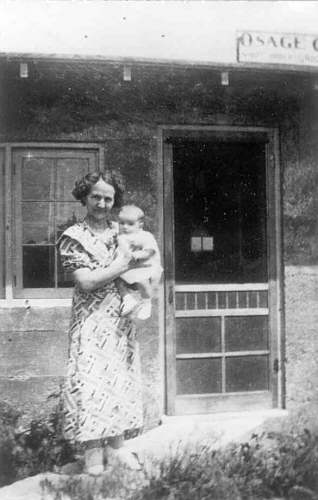 22 Sadie (Abbett) Bear and Carol Stillwell
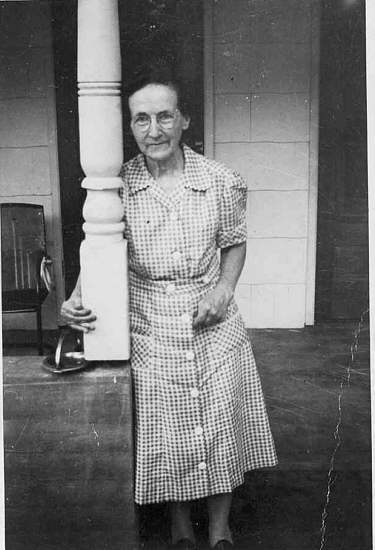 23 Sadie (Abbett) Bear
On Saturday of last week, Bob and Norma Higby were our volunteer hosts (photo 24). Bob taught for more than twenty five years in the school systems of Eldon, Camdenton and School of the Osage. His special area of training was as football coach for these schools. Bob and Norma have been very supportive of the museum activities especially as volunteer hosts.
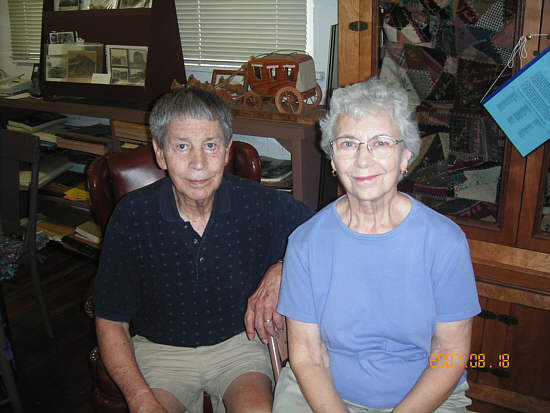 24 Bob and Norma Higby Last week I mentioned the celebration of the Eldon High School centennial and commented about all the new programs the High School offers today. One example of the training the students are getting is pictured here (photo 25). This bicycle was constructed from computer programs which controlled the machinery used to make the wooden bicycle and was good enough to win several awards (photo 26). You may remember that last week I featured some of the hand crafted wooden items made by some native Miller County residents; now it seems their descendents are learning how to make similar items by computer! You can view this bicycle on display in our museum.
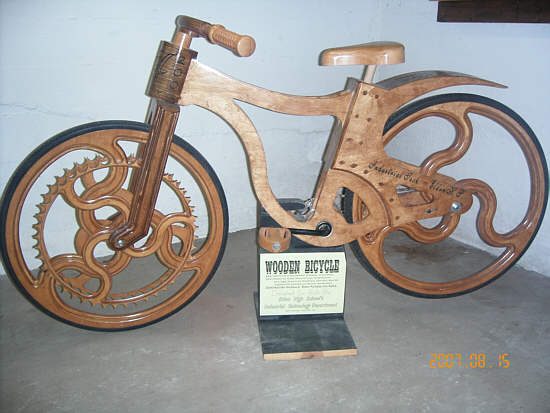 25 Wooden Bicycle made by EHS Industrial Technology Class
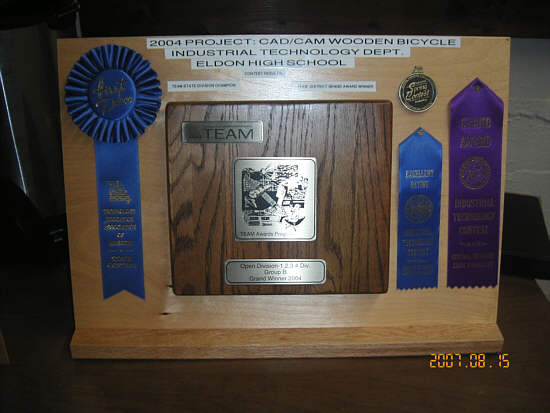 26 Bicycle Award Pictured here is another one of the log houses in the county (photo 27). This one is interesting because it was the home in which our Association secretary and esteemed historian, Peggy Hake, was born. Here is what Peggy wrote me about this old house and some of the related history:
"Yes, I was born in this old house in August 1935. My mother said the night I was born a terrible thunderstorm moved through the area and the doctor only made it to the old farmhouse about 15 minutes before I was born! I think the old doctor was Dr. George Washington Duncan of Iberia who lived until 1941. The house was located southwest of Iberia in what is known as the "Pleasant Hill community". It was located on the land that had been homesteaded by John Levi Whittle (my great, great grandfather) in the late 1840s. Levi Whittle was killed in the Civil War at the "Elsey Farm Fight" east of Iberia in August 1862. (This is the only recorded Civil War battle in Miller County although there were many fights and skirmishes in the area during the years of the war.) My great grandfather, Josephus Whittle, was his only son, and received the many acres that had been homesteaded earlier. Joseph and his wife, Leatha Jane (Loveall), were parents of 10 children (2 died in infancy) and the 8 who survived to adulthood were given 80 acres of land each. My grandmother (Elizabeth/Lizzie Whittle Wyrick--Mrs. Chesley S.Wyrick) was one of the 8 children who received 80 acres and it was on this land I was born in 1935. Josephus and Leatha Whittle also owned the general store with living quarters at the small town of Hawkeye over in Pulaski County. The store was given to their oldest daughter and husband, Carrie (Whittle) and Perry T. Wyrick. The other 7 children received the farm land in southern Richwoods township of Miller County.........I took this picture about 1977 long after the old house had been abandoned and was ready to fall down."
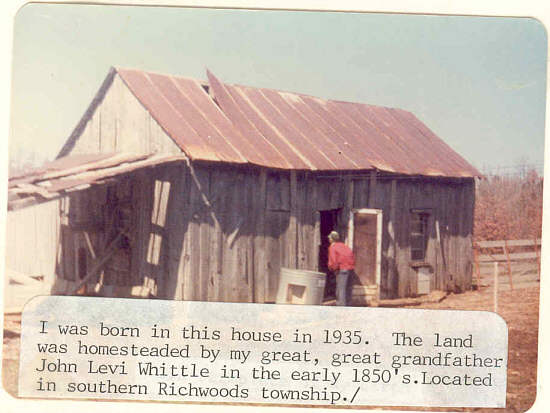 27 Whittle Homestead Another old log building was photographed this week on Dry Creek Road (photo 28). It has a door and no windows suggesting it once was a smoke house. Smoke houses were used for a very important reason by Miller Countians of the past (and now for that matter) to preserve their meats after butchering. In fact, hog butchering, or "hog killing" as it was called sometimes is the subject of our next segment of the recorded conversation of Arthur and David Bear (photo 29) which was done in 1992 in Tuscumbia. I have some photos of butchering hogs but since that could be a somewhat off putting subject for some people I have decided to refer those who want more information to go to the following website rather than display them directly with the narrative:
(http://thelibrary.springfield.missouri.org/lochist/periodicals/bittersweet/wi74d.htm) .
This site was taken from a periodical named Bittersweet started in 1973 at Lebanon Missouri High School ) by English teacher Ellen Gray Massey and a group of interested high school students, sophomore through senior, in a special English class dedicated to preserving the crafts, lore, legends and personalities of the Ozarks. The site has a series of photographs taken of all the steps of butchering a hog as well as how to make sausage and cracklin's. But don't unnecessarily avoid the web site listed above since it has really interesting photos which go right along with today's conversation by Arthur and David about hog butchering; they are quite realistic in depicting how it used to be done (and still is on some farms today).
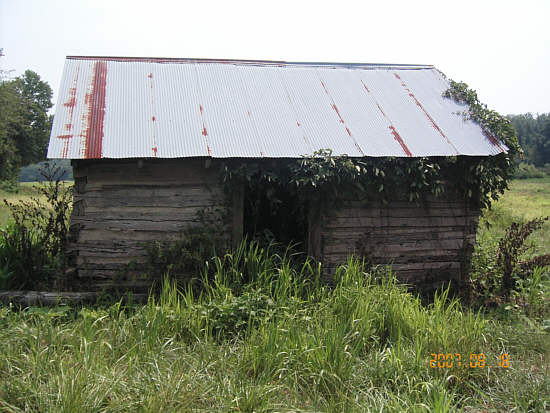 28 log smoke house Dry Creek Road
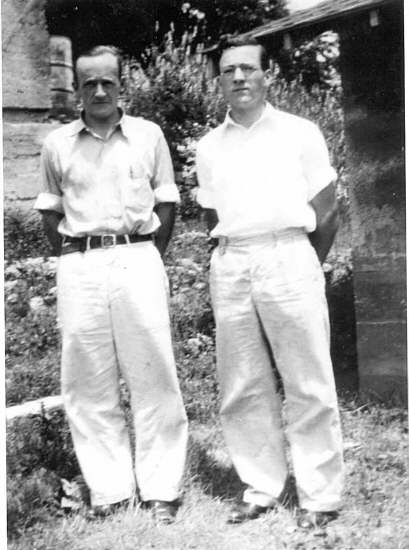 29 Arthur and David Bear
So here is the conversation between Arthur and David Bear about how they butchered hogs on the Bear farm on Dog Creek:
David: Butchering in the fall was an important time on the farm, and this was done, I suppose, Arthur, in November or December while the weather was cool enough for meat to keep. They didn't want any spoilage. Life on the farm in these early times required much sharing of labor between farmers and neighbors. In
peak times like I mentioned earlier, the threshing machine
required many men. The owner of the threshing machine would
go from farm to farm, and the neighboring farmers would come
with their wagons and teams of horses to help with the labor.
This was true of many of the activities that required intensive
labor. Hog killing was another one of those times, though it
didn't require as much help as the threshing. I would like
for you, Arthur, to discuss the hog-killing time activities since
you observed much of this while we were still on the farm.
So, Arthur, why don't you describe some of the things you remember, and also details about the curing of the meat?
Arthur: I can remember it pretty well. Dad would be up before
daylight and would get a fire going outside. He would have
big logs on the fire with large stones on top of the fire.
Some of the stones weighed 30 to 40 pounds. The stones would
stay in the fire until red hot or white hot. Wooden barrels
were used in the scalding. The hot rocks would be immersed
in a barrel of water and get the water boiling hot, or almost
boiling hot. In the meantime, while someone was doing that,
someone would shoot a hog between the eyes with a 22 rifle.
Then someone would run up with a sharp butcher knife and cut
the jugular vein and let him bleed. As soon as he had bled
pretty good, they would have two men and maybe three ('cause
the hogs would weigh 200 pounds or more) douse him head first
in the barrel of hot water. They would then pull it out and
douse the other end. This process loosened the hair so it would
scrape off easily. The hog would then be placed on a platform
and about two people would start scraping until the skin was
just as clean as they could get it. I remember helping scrape.
While the scraping was going on, someone would shoot another
hog and the process would be repeated. Women and children could
do the scraping while the men worked on another hog. Well!
We got them all scraped, then we would have to hang them. We had what was called gambrel sticks that were sharpened on both ends. We put the sharp end through the heel string or tendons on the hog's hind legs. This was to hang the hog, and it was heavy
work. It had to be lifted high enough so the head wouldn't
touch the ground. Then we would start the eviscerating or
disemboweling. We would cut the hog open from top to bottom down the middle of the belly. The insides would fallout into a
tub so they wouldn't hit the ground. It was important that
the inner parts not get dirty. There was much fat inside to
render into lard. Also, the liver and the heart were used.
David: And kidneys?
Arthur: Yes, but we didn't do much with the kidneys. We did
with the heart and liver. After the butchering of several hogs,
the two or three neighbors who had helped, would select
some of the meat; a shoulder or a ham to take home with them,
and then when they butchered, we would be paid back. I remember
that Billie Bear would come over, Lou Crismon, and maybe another.
David: Vic Nixdorf?
Arthur: Yeah, and we finally got the hog gutted and laid out,
and then we couldn't do much in cutting it up until he cooled
out. It was soft and flabby while warm and the butcher knife
would go everywhere if we tried to use it. Later we quartered
the hog and removed the head. Butchering was a big job, not
only for the men, but for the women, too. Well, the next day
after the meat had cooled out over night, the meat would work
pretty good. You could take a sharp knife, and we did it
differently then than we do now. Now, they split the hog right
down the middle of the back bone, and take the loin out and
make pork chops. Well, we didn't do it that way.
David: They use power saws today.
Arthur: Yeah, Didn't have equipment like that then. Then,
we made backbone, took the ribs out, and cut out the lean part
for tenderloin.
David: This was not just an activity for men. The women's
work started as soon as the hog was cut down. The rendering
of the lard was a term used for the cooking of the fat pieces
to get the grease out for storage, and for use throughout the
year. Then came the making of the sausage, head cheese or
whatever in an attempt to use the various-parts of the hog.
After the meat had set for several days in a cool place, the
curing process would start. Tell us something about that,
Arthur.
Arthur: Well! I'll say just a little about the rendering for
one thing. When they trimmed the shoulder, hams, and sides
a lot of the fat would be cut off. We would cut this in small
pieces. Then the rendering was done outside in a large iron
kettle over an open fire. This was an old black kettle, I guess
it would hold 30 gallons or so. It was pretty big. Then, as
you said, in the trimming process, there would always be a lot
of lean meat for sausage. The choicest piece of lean meat-was
the tenderloin which was trimmed from around the backbone.
This was a delicacy which was fried for immediate use. And
we would trim the heads good. Mom would make head cheese out
of part of that, and part of it would go into mincemeat for pies. So. there was a lot of work for the women. too. As I
remember. Mom did most of the rendering of the lard. Then when
the meat cooled out. we put it in the smokehouse for overnight
where a marauding animal couldn't get to it. Dad then put a
little salt on it that evening. That really drew water out
of it. The next morning. there would be water all over. Dad
would pick up each piece of meat and turn it over to drain the
water off. and then salt it heavily. The meat would then take
salt for a period of time. and I am not sure how long that was.
but it was probably two-or-three weeks. Then after it had taken
salt. we would run wires through the hams. sides. and shoulders
and hang it up to the rafters in the smokehouse. We had a
smoke house. as we called it. Didn't have any floor in it.
Dad would build a fire out of hickory wood and shut the door
and smoke the meat for, oh, for two or three days. After that.
we could keep the meat all winter and through the summer.
Although there were times when flies would get to it and you
would lose a piece of meat now and then. But as a rule you
could keep it a long time. Then if you wanted to sugar cure
it to add more flavor. you made a solution of brown sugar, salt
and pepper. and anything else you wanted for taste. This was
applied liberally over the meat.
David: Was this in addition to the hickory smoke?
Arthur: Yeah. yeah. That was in addition.
David: What did the hickory smoke do to it?
Arthur: It just gave it a heavy smoke flavor. Today's curing
eliminates the hickory smoking process and uses a smoke flavored
liquid. but in the earlier days we used the real thing.
David: One thing I remember that Mom did was to can the sausage
in fruit jars. She would fry it and put it in the jars and
cover it with pure lard up to the top. Cooked sausage canned
like this would last for a very long time. Sometimes she would
put it in a large crock. not sealed. But just preserved in the
fat. That was very interesting. and I can remember how tasty
all this food was. Especially, the bacon, sausage. and ham.
Country cured ham was a taste that was out of this world. I
can still taste it in my mind. but I wish I could taste it for
real. They just don't make it like that anymore that I know
of.
Arthur: Sausage was one of the real prizes from butchering. Sausage and hot biscuits and gravy with some sorghum molasses thrown in made a meal a real treat. We really ate good.
David: Yeah. and that tenderloin tasted good. too. That is
the meat from around the backbone. Today it would be in pork
chops. I tell you. the farmers had real food. and the women
knew how to cook it and make it real tasty.
At another setting. we want to go into other aspects of farm
life related to food production. The farmers really produced
just about everything they ate throughout the year. We will
now sign off and come back later to talk about other foods produced and eaten by our families who lived in and around these hill farms.
Next time Arthur and David will discuss other common foods grown and processed on their home farm back in the early part of the last century.
On Saturday of last week Niki Angel (photo 30), Wayne Wickham (photo 31) and myself toured the Dog Creek area to revisit the original home site of the Bear family. Niki's great great grandfather was John Bear and Wayne's grandfather was David C. Bear. John and David were brothers and the sons of George Bear, the original Bear to come to Miller County with his family in 1857. He settled on a farm on Dog Creek where now highway 52 divides the farm about three miles east of highway 17. Several of the Bear brothers settled farms in this area as shown in this plot map of 1905 (photo 32). The original Bear home is no longer standing; in its place is a home (photo 33) built by George (usually called Billy, and who was a son of George Sr.) and Jennie Bear after the first home burned many years ago. Later we visited a farm on Coon Creek where at one time David C. Bear had a farm where a very beautiful view can be found looking north toward Dog Creek (photo 34). Niki, who now resides in New Mexico, is the granddaughter of Ross Adcock and grand niece of Garland Adcock. As a young girl she visited them often and remembers helping Uncle Garland at his service station located at the junction of highway 52 and 17 south of Tuscumbia. The building currently is the location of the Red Oak Inn restaurant (photo 35) owned by Wes Horton, a very popular place for locals as well as visitors to the area to dine. Wayne was born and raised on the Wickham farm which is located a few more miles to the east on highway 52 close to St. Elizabeth where he attended school. Both Niki and Wayne are cousins of mine. Here are some photos of the Coon Creek area (photos 36 and 37).
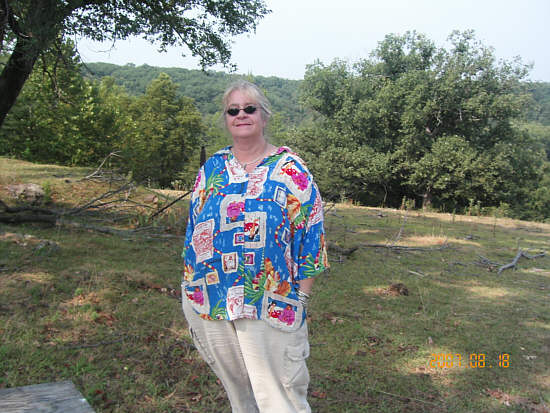 30 Nikia Angel
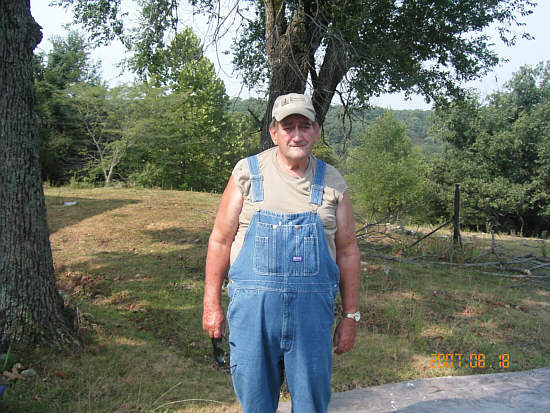 31 Wayne Wickham
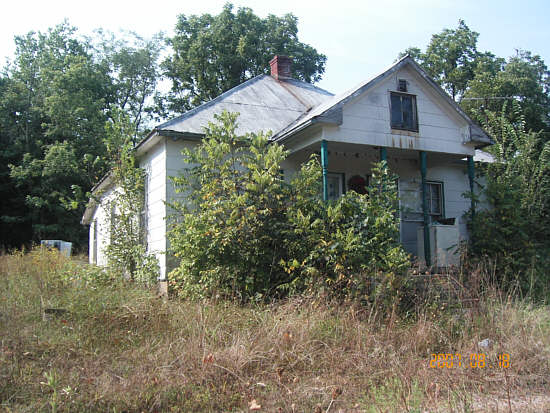 33 George and Jennie Bear home
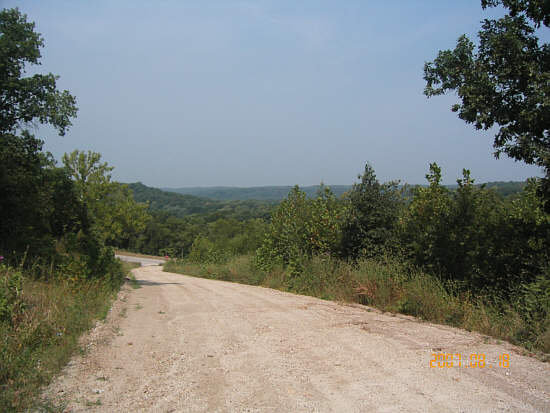 34 Coon Creek road looking north
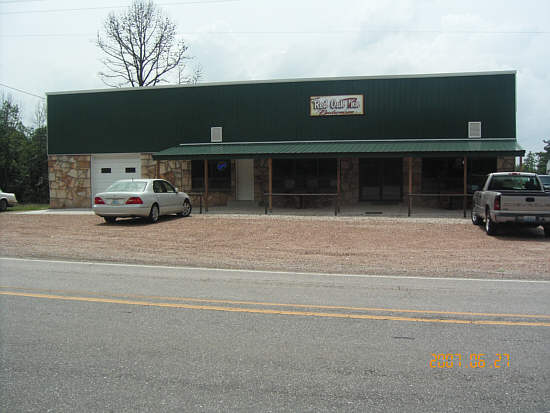 35 Red Oak Inn
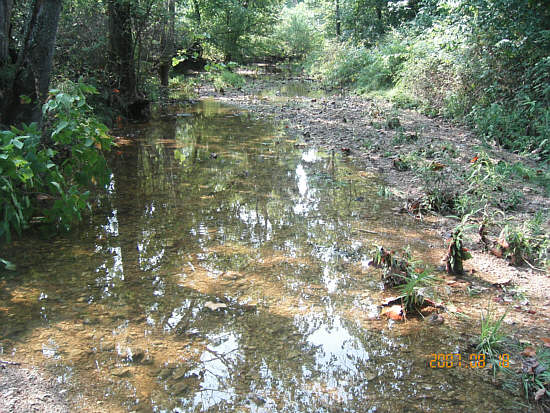 36 Coon Creek
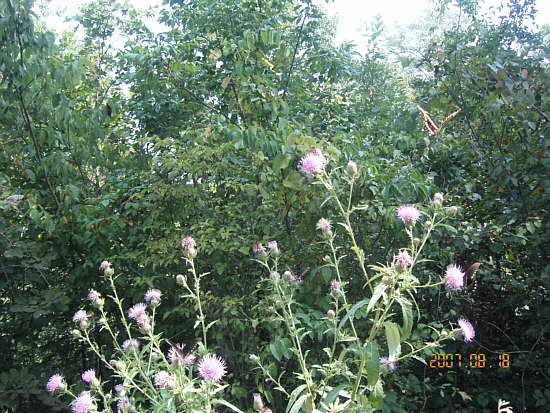 37 butterflies
The next item is a variation of the "what is it" photo. This week the photo more qualifies as a "isn't that a funny looking thing." It looks like a "Tree Monster" from a "Forest Wars" movie (photo 38). The tree straddles Dry Creek north of Tuscumbia.
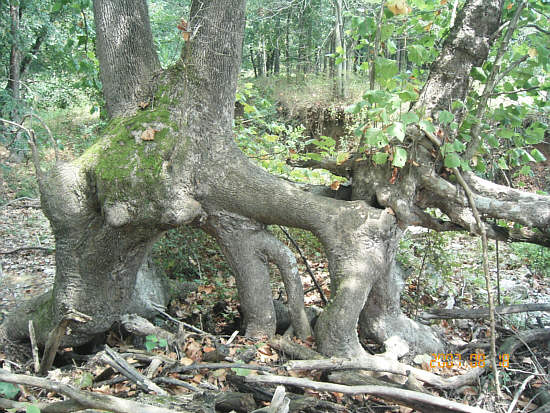 38 Tree Monster
I am scheduled to be interviewed by Vickie Cramer on KRMS Radio 1150 on Tuesday, August 28 at 4:30 p.m. regarding our building program and funding drive. I will be happy to report on the radio that our funding drive has been a successful effort meeting expenses thus far. However, we have had some unexpected costs, especially those associated with having to re roof the old museum building. So we are not finished with our fund drive, especially since we still have to purchase needed items for the research area and new displays. If you would like to help us with these efforts, please mail donations to:
Miller County Museum Fund Drive
P.O. Box 57
Tuscumbia, Mo. 65082
That's all to report this week.
| 


